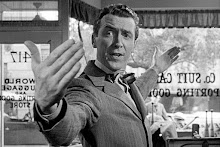What I love about the Wallace and Gromit films on this technical level is how well it utilizes the stop-motion aspect of its visual style. This is most evidently seen through the character of Gromit, a dog who never speaks (I know, bizzare isn't it), and is entirely reliant upon physical actions and facial expressions to convey his feelings. Even without a mouth, it's effortless for the audience to understand what Gromit's trying to communicate or what he's going through, through each scene. It really is rather impressive that this form of animation can give so much life by itself. As for Wallace, his visual panache is added to by the perfect vocal work of Peter Sallis.
Anyway, I've gotten that initial praise out of the way. Now to each specific short and why each of A Grand Day Out, The Wrong Trousers and A Close Shave are such remarkable, distinct examples of Nick Park (I saw A Matter of Loaf and Death a while ago but don't remember all that much about it, but I remember liking it, and I'll hold off on The Curse of the Were-Rabbit for now).
A Grand Day Out is probably the simplest of all of Park's shorts. Now that's not to diminish its quality at all. As a debut it's an incredibly strong work, which tells the simple tale of Wallace and Gromit, sans cheese on a bank holiday, decide to take a trip to the moon, which 'everbody knows is made of cheese'. Watching this particular short always makes me feel a bit hungry, the aesthetic of the moon is particularly well done here as it has such a character all of its own, and manages to make the surface of a planet look quite scrumptious to be had with tea and crackers.
It's funny and sweet, perhaps not as much as the following two shorts, but also shows evidence of a later development towards Park's remarkable use of tension and heart to combine into a thrilling experience. For example take the scene where Wallace forgets the crackers; that's some genuinely heart-pounding stuff:
The Wrong Trousers is probably my favourite of this 'trilogy'. It's about Wallace's invention of a pair of 'Techno Trousers', and the welcoming of a dubious guest, a penguing named Feathers McGraw, to the household. McGraw's appearance was always a bit creepy to me as a child and still makes me feel a bit uneasy now, especially with regards to the character's secret guise as a diamond thief. Moreover, his gradual barging into his relationship with Wallace compels Gromit to tearfully move out. It's every bit as heartbreaking to watch as it was all those years ago.
The film has many a great scene, but the highlight for me has to be that final chase scene on a train--a toy train set that is. It's the exact sort of dynamic visual comedy mixed with vivid action that's employed by the likes of Edgar Wright and George Miller today for their own chase scenes. A scene like this would be impressive in any context, and when you think about how much time and effort had to be spent in the construction of the set, the use of different angles, the movements of each character along with their facial expressions (also the penguin's lack of one has always made him an even more chilling adversary in my opinion), it really makes you tremble with wonder.
A Close Shave sort of provides a culmination of all the fantastic work of Nick Park and Aardman Studios over the course of their shorts as it shows all the advancements in stop-motion animation with its larger scope, even more action setpieces, and multitudes of new characters including, yes, Shaun the Sheep.
The short film is exquisitely structured in its short running time as not only a fun ride throughout with new characters and setpieces, but also a statement on the whole series of the relationship between Wallace and Gromit, as well as an introduction to the highly succesful Shaun the Sheep show.



No comments:
Post a Comment